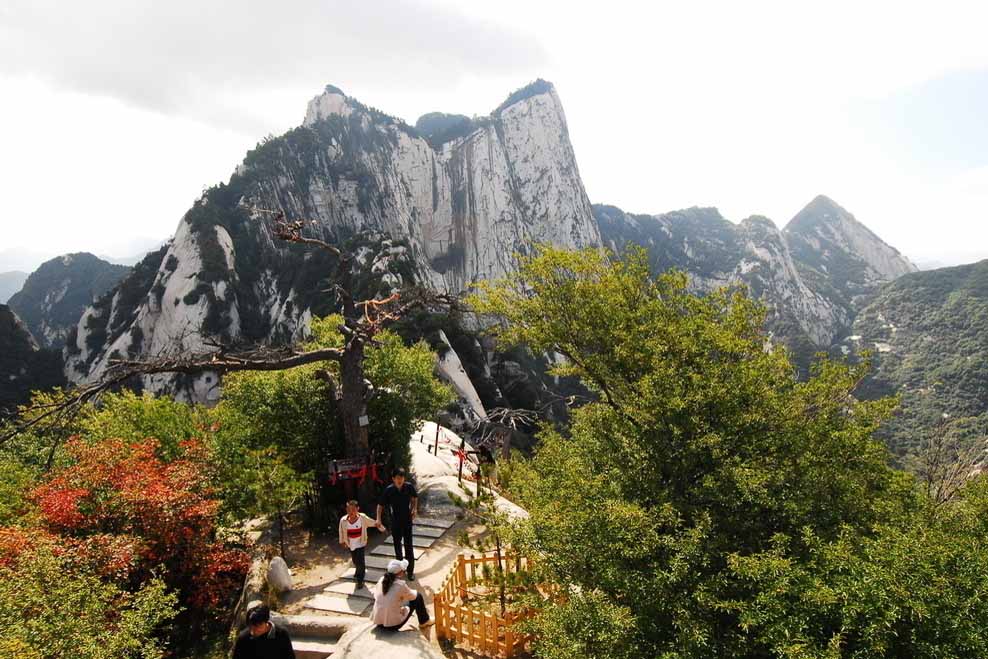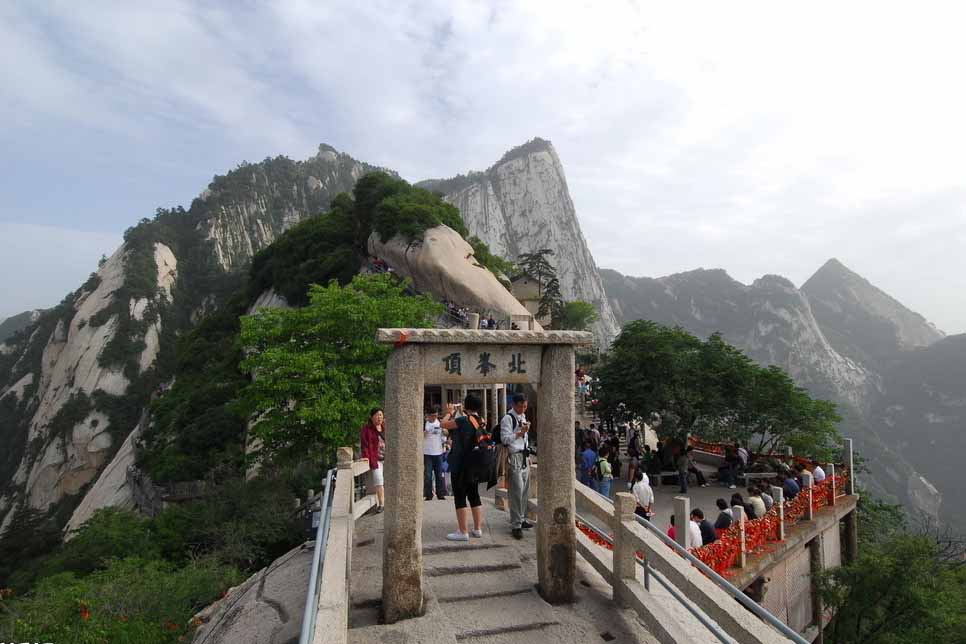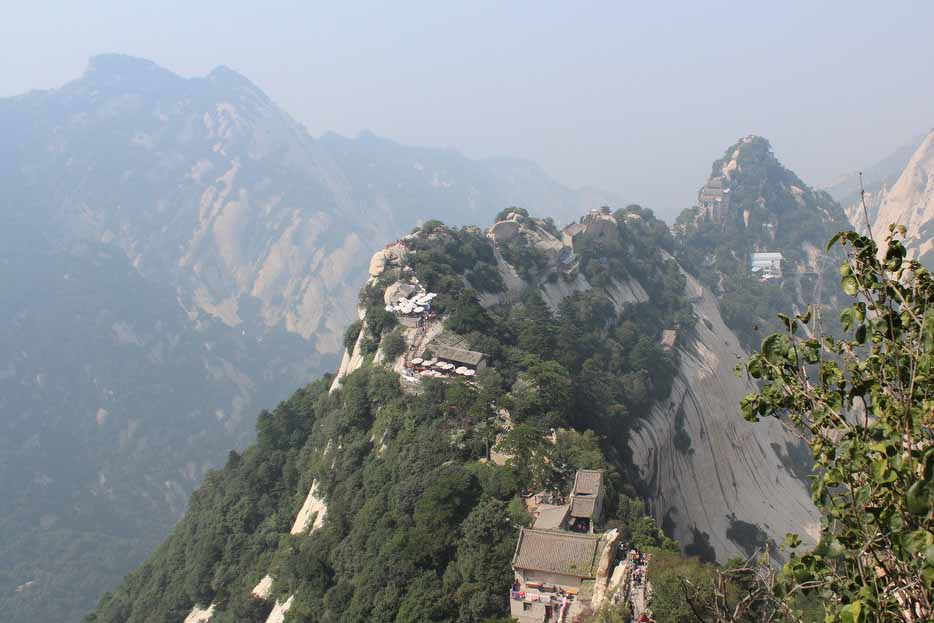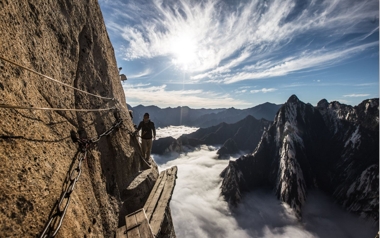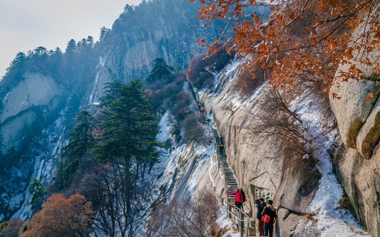Home > Attractions >
Huashan Mountain
As one of the most dangerous and spectacular mountains in the world, when minibus ascends the winding road to Mount Hua, the jagged scenery unfolds like a captivating piece of Chinese calligraphic art.
The Introduction of Mount Hua
Huashan, formerly known as "Xiyue", it is one of the five great mountains in China. It is located in Huayin City, Shaanxi Province, and it acclaimed as "the most dangerous mountain in the world". In addition, Mount Hua is also known as "Taihua Mountain", it is the cradle of Chinese civilization, it is sauid The "Hua" of "China" and "Huaxia" was originated from Mount Hua.
Overhanging rock and distant precipices wink from above, and clumps of vegetation peek out from mysterious crevices Hua Shan's awe-inspiring peaks will take your breath away. Located some 74 miles (20 km) from the ancient capital Xi'an in Shaanxi Province Hua Shan is the result of dramatic tectonic movements millions of years ago, and is one of China's most perilous mountain areas. Although covering an area of just 58 square miles(150 km ), Mount Hua is inundated with over 70 peaks and ridges.
The word "adventure" is the best description of Huashan scenery. The Chang Kong Cliff Road and the Hundred-foot gorge and the other peaks, which is quite amazing. Furthermore, Huashan scenic spot covers a vast area, including the main peak scenic spot, Xiyue Temple scenic spot, Xianyu scenic spot and so on. The main peak scenic spot is the core scenic spot of Huashan, including the "Huashan Road" and the five great peaks.
Five Great Mountains
The most outstanding peaks are North,South. East, West and Central-they stand like the Petals of a lotus flower reaching for the heavens. These five imperious peaks gaze over the Wei and Yellow Rivers in the north and embrace the Qinling Mountains in the south.
At 7, 085 feet(2,160 m), South Peak tops the lot. Her closest rivals are East Peak and West Peak. The Central Peak, also called Jade Maiden Peak and the North Peak are slightly less statuesque but equally beautiful. In the early mornings and late evenings, cushions of mist dramatically swirl around these granite peaks, lending a romantic and mythic air.
All five peaks are accessible by foot, and for even the most lethargic- by cable car. The Austrian built cable car has its terminus at the "base"of Hua Shan and ferries visitors to the North Peak.
What to visit in Mount Hua?
There are more than 210 famous scenic spots in Huashan, throughout history numerous scholars have left various classical poems here.
Nine Cliffs
Looking onto the Wei River, Touching Ear Cliff, Thrusting Into the Clouds Cliff, Sacrificing Oneself Cliff, Escaping the Imperial Edict Cliff, Bright Star Cliff, Sun and Moon Cliff and Immortal's Palm Cliff. There are also eight viewing platforms with colorful names like the Three Emperors, Immortals Gathering and Purple Vapor, they are built in traditional styles in harmony with the area's natural beauty, the view from any angle is pretty neat.
Mountain rivulets meander along the many twists and turns of metamorphic rock. The water is funneled into a dramatic Qingke Waterfall, about 6.2 miles (0 km) from the mouth of the valley.
Changkong Cliff Road
Changkong Cliff Road is situated on the eastern side of Huashan Mountains, the road was created in the 13th century, during the Yuan Dynasty, by followers of He Zhizhen, the first master of the Mount Hua Sect of Taoism, at that time, the monks were seeking immortals who were believed to dwell in the mountains. The walkway is made of wooden boards,nailed together and installed on a series of iron pegs driven into the sheer mountain cliff thousands of metres above the ground. Some sections of the walkway are only 30 cm wide, although the walkway is popular with visitors, however, due to a number of fatalities have occurred and tourists have to wear the safety harnesses and move slowly along the side.
Dark-green Dragon Ridge
The climb up the 5,293-foot-high(1,614 m) North Peak starts off gradually enough but you've just begun a 3.7 mile(6 km) trek that includes over 3 000 steps. Most of the steps are in good condition and though some are horizontal incisions trying to pass off as steps, chained railings help the ascent At a leisurely pace, it takes an average 2 to 3 hours. The route presents several opportunities to test your mettle: Heavenward Ladder, Sun and Moon Precipice and the sinewy dragon shaped ridge in front of West Peak, called Dark-green Dragon Ridge.
After the first 500 steps, there's a platform fortunately one of several, where you can rest and soak in the tranquility. On a sunlit day, the sun's rays cast dramatic light and shadows against the rocky surfaces. Endless steps snake through trees, boulders lush greenery, and over rippling brooks. You've been transported into the underbelly
of a heaving canyon.
With each step, even more captivating scenery unfolds. The skyscrapers of New York or Shanghai are chopsticks when compared to the towering beauty of Mount Hua.
Turtle Carrying Stone
Although you're at the halfway point of North Peak, that last set of steep steps was only the aperitif. A longer 1.500-step stairway, Huangfu Col path, awaits you on a huge mound, called Turtle Carrying Stone by the locals. Tigers and black bears once prowled the southern slopes. The shy and elusive denizens of Hua Shan include mountain goats, snakes squirrels and monkeys on the West Peak.
Once over the Turtle Carrying Stone hurdle, the peak-end of the cable car terminus looms into view. It gleams like a champion's trophy. People hover at the foot and mountaintop of Hua Shan. Human prattle soon replaces the chirping of birds. The hum of the cable car gets louder and drowns out the trickling sound of running water.
Sun Facing Peak
As the saying goes:" the early birds gets the worm", is absolutely true on Huashan. If you sleep in, you' ll lose out on a gorgeously sensual sunrise. At around 6 AM, the warm rays of the sun caress your skin, cool from the fresh morning breeze. You thaw slowly, as if just waking up from hibernation. Your sore muscles may take a bit more persuasion to work the morning after your "Huashan-scalathon." East Peak, sometimes called Sun Facing Peak, even has a viewing platform for sun lovers.
Yuquan Yuan and Xiyue Temple
Get a move on early if you want to visit the rest of the four peaks, not to mention the many ridges, caves, pavilions, sculptures engravings, Buddhist and Taoist temples such as the Yuquan Yuan and Xiyue Temple.
Xiyue Temple, also known as Huayue Temple, it is a temple where emperors can offered and sacrificed to the great emperor of Xiyue, Shaohao. The temple was built in the Yuan Guang period of Emperor Wu of Han Dynasty (134-129 B.C.) and it was built at the foot of Huashan Mountain. Emperor Huan of the Eastern Han Dynasty (147-167 A.D.) moved to the site and changed it to the present name. The Tang, Song, Ming and Qing dynasties have been renovated many times.
South Peak or Dropping Goose Peak
Hua Shan's highest point is South Peak or Dropping Goose Peak. Along it is a planked route lined with iron chains, which guide the very adventurous, or foolish, up a nerve racking path, waves of clouds drift above a fantastic horizon of mountain ranges and distant river waters.
Other landscapes
On West Peak in front of Cuiyun Temple, sits a massive lotus shaped rock called Lotus Peak Beside the temple is another deeply scarred crack called Axe-splitting Rock. Legend goes that filial youth by the name of Chen Xiang used a giant axe to crack apart the mountain to rescue his mother. The northwest face of West Peak drops so steeply it appears to be cleaved by a sharp sword, hence its name “Fatal Cliff”, the eastern face Is lush with dense forest.
Sightseeing Methods
1. Huashan (main peak scenic area) has two mountain gates (entrance): Dongshan Gate and Xishan Gate (also known as Huashan Gate), visitors can take the ropeway up the hill to go to Dongshan Gate, or enter from Xishan Gate. At present, Huashan has two rope ways on the East and West lines, it can reaching the north and West peaks respectively.
2. North peak have long mountain road, and the ropeway is quite short, so it is suitable for people who have better physical strength or experience in mountain climbing.
3. Generally, panoramic tours choose the West Peak to the north peak. Although there are many mountain roads, most of them are downhill, which requires general physical strength.
Travel Tips of Mount Hua
Please be careful, when you visiting Huashan Mountain, and tourist have to prepare some safety harnesses, because every year there are accidents where tourists fall from Huashan.
Admission Fee:
Peak season: 160 RMB ( 1ST March to 30th November)
Off season: 100 RMB ( 1ST December to 28th February)
Cable Car Ticket: one way 80 RMB/person, return ticket 150 RMB
Opening Time:
Peak season: 7.00AM to 7.00PM
Off season: 9.00AM to 5.00PM
The Introduction of Mount Hua
Huashan, formerly known as "Xiyue", it is one of the five great mountains in China. It is located in Huayin City, Shaanxi Province, and it acclaimed as "the most dangerous mountain in the world". In addition, Mount Hua is also known as "Taihua Mountain", it is the cradle of Chinese civilization, it is sauid The "Hua" of "China" and "Huaxia" was originated from Mount Hua.
Overhanging rock and distant precipices wink from above, and clumps of vegetation peek out from mysterious crevices Hua Shan's awe-inspiring peaks will take your breath away. Located some 74 miles (20 km) from the ancient capital Xi'an in Shaanxi Province Hua Shan is the result of dramatic tectonic movements millions of years ago, and is one of China's most perilous mountain areas. Although covering an area of just 58 square miles(150 km ), Mount Hua is inundated with over 70 peaks and ridges.
The word "adventure" is the best description of Huashan scenery. The Chang Kong Cliff Road and the Hundred-foot gorge and the other peaks, which is quite amazing. Furthermore, Huashan scenic spot covers a vast area, including the main peak scenic spot, Xiyue Temple scenic spot, Xianyu scenic spot and so on. The main peak scenic spot is the core scenic spot of Huashan, including the "Huashan Road" and the five great peaks.
Five Great Mountains
The most outstanding peaks are North,South. East, West and Central-they stand like the Petals of a lotus flower reaching for the heavens. These five imperious peaks gaze over the Wei and Yellow Rivers in the north and embrace the Qinling Mountains in the south.
At 7, 085 feet(2,160 m), South Peak tops the lot. Her closest rivals are East Peak and West Peak. The Central Peak, also called Jade Maiden Peak and the North Peak are slightly less statuesque but equally beautiful. In the early mornings and late evenings, cushions of mist dramatically swirl around these granite peaks, lending a romantic and mythic air.
All five peaks are accessible by foot, and for even the most lethargic- by cable car. The Austrian built cable car has its terminus at the "base"of Hua Shan and ferries visitors to the North Peak.
What to visit in Mount Hua?
There are more than 210 famous scenic spots in Huashan, throughout history numerous scholars have left various classical poems here.
Nine Cliffs
Looking onto the Wei River, Touching Ear Cliff, Thrusting Into the Clouds Cliff, Sacrificing Oneself Cliff, Escaping the Imperial Edict Cliff, Bright Star Cliff, Sun and Moon Cliff and Immortal's Palm Cliff. There are also eight viewing platforms with colorful names like the Three Emperors, Immortals Gathering and Purple Vapor, they are built in traditional styles in harmony with the area's natural beauty, the view from any angle is pretty neat.
Mountain rivulets meander along the many twists and turns of metamorphic rock. The water is funneled into a dramatic Qingke Waterfall, about 6.2 miles (0 km) from the mouth of the valley.
Changkong Cliff Road
Changkong Cliff Road is situated on the eastern side of Huashan Mountains, the road was created in the 13th century, during the Yuan Dynasty, by followers of He Zhizhen, the first master of the Mount Hua Sect of Taoism, at that time, the monks were seeking immortals who were believed to dwell in the mountains. The walkway is made of wooden boards,nailed together and installed on a series of iron pegs driven into the sheer mountain cliff thousands of metres above the ground. Some sections of the walkway are only 30 cm wide, although the walkway is popular with visitors, however, due to a number of fatalities have occurred and tourists have to wear the safety harnesses and move slowly along the side.
Dark-green Dragon Ridge
The climb up the 5,293-foot-high(1,614 m) North Peak starts off gradually enough but you've just begun a 3.7 mile(6 km) trek that includes over 3 000 steps. Most of the steps are in good condition and though some are horizontal incisions trying to pass off as steps, chained railings help the ascent At a leisurely pace, it takes an average 2 to 3 hours. The route presents several opportunities to test your mettle: Heavenward Ladder, Sun and Moon Precipice and the sinewy dragon shaped ridge in front of West Peak, called Dark-green Dragon Ridge.
After the first 500 steps, there's a platform fortunately one of several, where you can rest and soak in the tranquility. On a sunlit day, the sun's rays cast dramatic light and shadows against the rocky surfaces. Endless steps snake through trees, boulders lush greenery, and over rippling brooks. You've been transported into the underbelly
of a heaving canyon.
With each step, even more captivating scenery unfolds. The skyscrapers of New York or Shanghai are chopsticks when compared to the towering beauty of Mount Hua.
Turtle Carrying Stone
Although you're at the halfway point of North Peak, that last set of steep steps was only the aperitif. A longer 1.500-step stairway, Huangfu Col path, awaits you on a huge mound, called Turtle Carrying Stone by the locals. Tigers and black bears once prowled the southern slopes. The shy and elusive denizens of Hua Shan include mountain goats, snakes squirrels and monkeys on the West Peak.
Once over the Turtle Carrying Stone hurdle, the peak-end of the cable car terminus looms into view. It gleams like a champion's trophy. People hover at the foot and mountaintop of Hua Shan. Human prattle soon replaces the chirping of birds. The hum of the cable car gets louder and drowns out the trickling sound of running water.
Sun Facing Peak
As the saying goes:" the early birds gets the worm", is absolutely true on Huashan. If you sleep in, you' ll lose out on a gorgeously sensual sunrise. At around 6 AM, the warm rays of the sun caress your skin, cool from the fresh morning breeze. You thaw slowly, as if just waking up from hibernation. Your sore muscles may take a bit more persuasion to work the morning after your "Huashan-scalathon." East Peak, sometimes called Sun Facing Peak, even has a viewing platform for sun lovers.
Yuquan Yuan and Xiyue Temple
Get a move on early if you want to visit the rest of the four peaks, not to mention the many ridges, caves, pavilions, sculptures engravings, Buddhist and Taoist temples such as the Yuquan Yuan and Xiyue Temple.
Xiyue Temple, also known as Huayue Temple, it is a temple where emperors can offered and sacrificed to the great emperor of Xiyue, Shaohao. The temple was built in the Yuan Guang period of Emperor Wu of Han Dynasty (134-129 B.C.) and it was built at the foot of Huashan Mountain. Emperor Huan of the Eastern Han Dynasty (147-167 A.D.) moved to the site and changed it to the present name. The Tang, Song, Ming and Qing dynasties have been renovated many times.
South Peak or Dropping Goose Peak
Hua Shan's highest point is South Peak or Dropping Goose Peak. Along it is a planked route lined with iron chains, which guide the very adventurous, or foolish, up a nerve racking path, waves of clouds drift above a fantastic horizon of mountain ranges and distant river waters.
Other landscapes
On West Peak in front of Cuiyun Temple, sits a massive lotus shaped rock called Lotus Peak Beside the temple is another deeply scarred crack called Axe-splitting Rock. Legend goes that filial youth by the name of Chen Xiang used a giant axe to crack apart the mountain to rescue his mother. The northwest face of West Peak drops so steeply it appears to be cleaved by a sharp sword, hence its name “Fatal Cliff”, the eastern face Is lush with dense forest.
Sightseeing Methods
1. Huashan (main peak scenic area) has two mountain gates (entrance): Dongshan Gate and Xishan Gate (also known as Huashan Gate), visitors can take the ropeway up the hill to go to Dongshan Gate, or enter from Xishan Gate. At present, Huashan has two rope ways on the East and West lines, it can reaching the north and West peaks respectively.
2. North peak have long mountain road, and the ropeway is quite short, so it is suitable for people who have better physical strength or experience in mountain climbing.
3. Generally, panoramic tours choose the West Peak to the north peak. Although there are many mountain roads, most of them are downhill, which requires general physical strength.
Travel Tips of Mount Hua
Please be careful, when you visiting Huashan Mountain, and tourist have to prepare some safety harnesses, because every year there are accidents where tourists fall from Huashan.
Admission Fee:
Peak season: 160 RMB ( 1ST March to 30th November)
Off season: 100 RMB ( 1ST December to 28th February)
Cable Car Ticket: one way 80 RMB/person, return ticket 150 RMB
Opening Time:
Peak season: 7.00AM to 7.00PM
Off season: 9.00AM to 5.00PM

